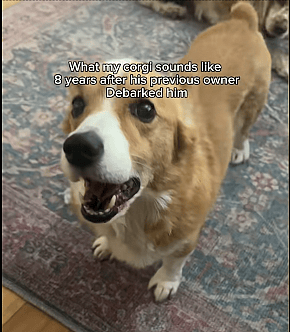Tears Flow as Sweet Corgi Tries to Bark But Can’t Make a Sound
As humans, we have our own verbal and non-verbal ways of communicating with one another. The same goes for dogs. Our furry friends rely heavily on their voices to express how they feel, not just to us, but to other animals. Every sound a dog makes, be it barking, whining, howling, or growling, is an instinctive form of communication that allows them to connect with those around them.
Dogs use their voices to let us know when they’re excited, scared, hungry, bored, in pain…basically any emotion they feel inside. Now, imagine how agonizingly tough it can be for a dog who’s unable to use their voice. And not because a medical condition stripped them of this natural ability, but because someone somewhere decided to have their vocal chords permanently removed. (Watch the Clip Below)
@teresa_jack Please help us continue to educate others on the consequences of this cruel practice. 🩷 #watson #corgi #watsonslaw #debarking #debarkeddog #animalrescue #rescuedog ♬ Sad and lonely – MoppySound
This is the heartbreaking reality of Watson, a 10-year-old Corgi who can’t bark, growl, or make any meaningful sounds of communication simply because his previous owner debarked him.
A LifeLong Struggle
Watson’s previous owner debarked him when he was still a young dog. It’s now eight years since Watson lost his ability to voice out his feelings.
As revealed in a recent TikTok video posted by his new mom, @teresa_jack, Watson’s previous family put him through this barbaric procedure to turn him into a more “quieter” & less barky family dog for apartment living. They had the option of finding another dog that would be a better fit for their household. Yet, they chose to take the cruel route of silencing Watson. They took away the most important part of Watson’s identity that made him feel “normal”. His voice.
What makes this even more heart-wrenching is that Watson’s instincts to voice out his emotions are very much alive. But each time he tries to let out a sound, the only thing that comes out is a hoarse noise that no one around him can correctly interpret. His struggle was captured in the heartbreaking video that has since left millions of TikTok users fighting back tears.
You can see the confusion in Watson’s eyes as he opens his mouth repeatedly; it’s as if he knows that a part of him is missing. Even though Watson now has a family that adores him to bits, it’s hard to accept that he has to face the horrors of his past every single day.
The Other Darker Side of Debarking
Sadly, being debarked left Watson with a behavioral struggle: reactivity. And the thing is, Watson’s reactivity isn’t out of aggression. He simply reacts because being voiceless makes him feel helpless. Watson can’t bark or growl to communicate his boundaries to people or other dogs, and so he becomes reactive whenever he feels uncomfortable. Reactivity is the only defense tool that Watson knows.

The American Veterinary Medical Association describes debarking as a surgical procedure that involves removing parts or all of a dog’s vocal cords to reduce the intensity, volume, or pitch of their bark. Experts say that debarking isn’t a justifiable solution to unwanted barking because it doesn’t get rid of a dog’s instinctive motivation to bark. In other words, a debarked dog still has the instincts to bark. Therefore, they’ll naturally attempt to make these sounds when they have a need to express. This is largely what makes debarking such an inhumane practice.
While debarking isn’t entirely banned across the USA, most states have strict regulations surrounding the practice. For instance, states like New Jersey, Massachusetts, and Maryland prohibit debarking unless a licensed veterinarian deems it medically necessary.
Generally, a dog’s vocal cords don’t regenerate once removed. But in cases where the vocal cords were partially removed, near-normal bark sounds may return within months of debarking.

